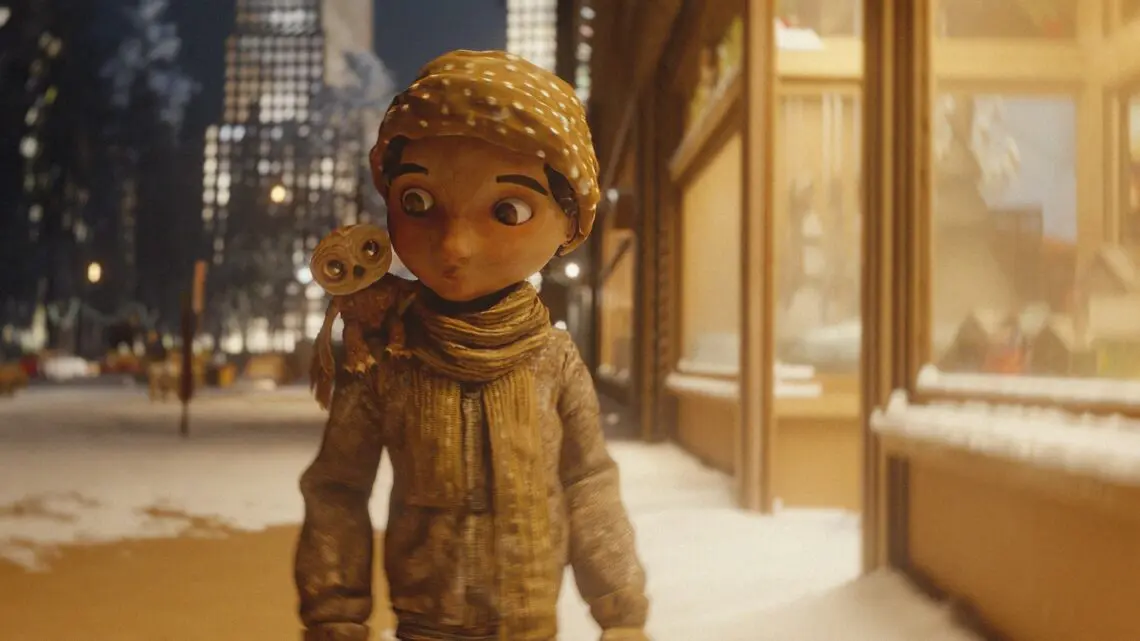The animated short “An Almost Christmas Story” completes Alfonso Cuaron’s trifecta of Christmas stories.
This time, he turned to “The Green Knight” director David Lowery to helm the storytelling. “It was almost exactly three years ago that I read the script for the first time,” says Lowery. He happened to be feeling very festive, and it was an instant yes to sign on. “It feels exactly the right thing to do. I love Christmas. I love the tradition of Christmas movies, and I love short Christmas films,” Lowery says. He also loved the idea of what Cuaron had done with “The Shepherd” and “Le Pupille,” creating a new series of films for Disney+ which hopefully, along with “An Almost Christmas Story ” would become perennial classics.
“An Almost Christmas Story,” now streaming on Disney+, is based on the true story of an owl that was rescued from the Rockefeller Plaza Christmas tree in 2020. The owl, named Moon, is taught the true meaning of Christmas as he seeks to be reunited with his family.
Popular on Variety Cuaron knew he was going to be involved solely as a producer and would leave it up to the director, in this case Lowery, to create the story’s vision.
At first, Lowery had the idea for it be live-action, but as he spent time on the script developing the story, he started to have other ideas. “I’ve done photo-realistic CG animals before, and they’re wonderful, and I love getting to do them. But in this case, I felt there was an opportunity for a wonderful level of whimsy, and that we could remove one degree of reality from this movie and make it a little bit more fantastical, more magical and a little bit more in keeping with the tradition of the Christmas films that I grew up loving.”
He decided to make all the animals “look as if they’re stop-motion.” The other challenge was filming in New York City over the holidays would be impossible, and with that, Lowery decided to embrace a fully animated world so he could have a greater degree of creative flexibility. Ultimately, he primarily focused on using CG animation that visually emulated stop-motion. He created texture by using cardboard-like textures.
The shift to animation also allowed Lowery to focus on the themes and bring those to the surface, particularly the theme of belonging.
One of the first scenes Lowery worked on with his editor Mike Melendi was the moment Luna (voiced by Estella Madrigal) and Moon are on the subway. “They find a meaningful connection with one another. When we saw that on paper, on storyboard and then the animatic, that revealed itself very early on to be the heart of the film,” Lowery explains.
Because it was essential to the film, Lowery reveals the scene was one that took a lot of reworking. “It was originally much longer and much busier and much more complicated, and because it was so essential to the movie, it also needed to be as simple as possibly could be, and we kept reducing and distilling it down to the core essence of what that connection between those characters was.”
Lowery worked closely with creative designer Nicholas Bateman who helped build New York City as a cardboard city. His brief for Bateman was simple, “Just set your team loose. Have everyone build a two-scale version of New York City, particularly Rockefeller Center and the areas around it entirely out of cardboard.” He adds, “They built everything to work as it really would; the taxis and automobiles. But, if you look closely, you’ll see it’s all built of cardboard.”
Cuaron was watching from afar. “I was fascinated David’s process and how he kept developing the tone.” He adds, “I learned how each one of these forms completely changed the tone. There was an innocence to the result.”
Lowey adds, “It became a fable or a fairy tale in a way that it wouldn’t have been in any of those other versions.”
Take a look at the storyboards below.

 Italian
Italian







